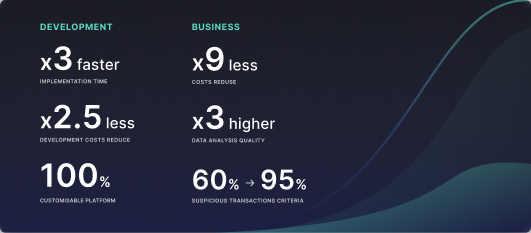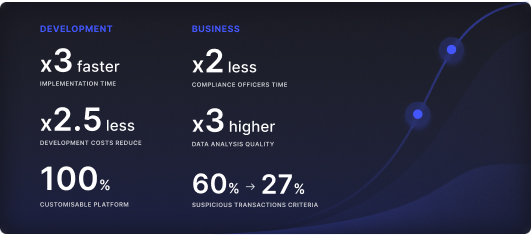Insurance: Underwriting
3.5x faster
5.1x faster

Issue:
Specific challenges include:
– Data Integration: Streamlining data integration from various sources while maintaining consistency and accuracy.
– Automated Decision-Making: Developing algorithms to automate underwriting decisions, reducing manual processing time.
– Compliance: Implementing robust measures to ensure regulatory compliance, including GDPR and HIPAA.
– Complex Underwriting Rules: Managing intricate rules for accurate decision-making while minimizing errors.
– Customization: Enhancing capabilities to cater to diverse client profiles and risk factors.
– Scalability: Designing for effective scalability to handle growing volumes without performance loss.
– System Performance: Optimizing performance for efficient handling of underwriting requests with minimal response times.
– Data Security: Implementing stringent security measures to protect sensitive client information.
The leading Canadian insurance company seeks to streamline its underwriting process, particularly concerning the assessment of medical and non-medical risks, including client profiles, medical records, and other relevant risk factors. The primary focus lies in addressing all the aforementioned specific challenges. The company aims to enhance efficiency, accuracy, and regulatory compliance in its underwriting processes to better serve its clientele and maintain its industry reputation.
Goal:
The underwriting project aims to enhance operational efficiency, reduce costs, and improve the overall quality and accuracy of underwriting decisions.
Solution:
To address the challenges outlined in the problem statement, our ProcessMIX-based solution enhances the efficiency and effectiveness of underwriting operations in the life insurance sector by implementing comprehensive solutions that optimize key areas of concern.
- Streamlining Data Integration: We optimize data integration to ensure underwriters have access to comprehensive information from multiple sources to use that data in the complex rulemaking process.
- Automating Decision-Making: created algorithms of processes and predictive analytics automate underwriting decisions, reducing manual intervention and processing time.
- Ensuring Regulatory Compliance: Stringent compliance measures are enforced through integration with diverse systems, gathering and consolidating new data, and accessing and validating internal resources.
- Managing Underwriting Rule Complexity: Our platform offers a visual, customizable framework for creating and implementing rules of any complexity underwriting, making it easy to create, understand, and test decision-making processes.
- Ensuring Scalability and Reliability: Cloud-based infrastructure ensures scalability and reliability to meet evolving workload demands.
ProcessMIX in action
All logic groups within the flow are categorized into respective groups based on the types of potential risks, with individual branches of logic designated for calculating each specific risk within each subgroup.
Let’s describe the scenario very simply.
- Each decision (“lifeDecision” or “criticalDecision”) is a field of type string. If no risks are detected (or none of the detected risks are declined), the decision value is set to “Accept”.
- If there are rating percentage values associated with some detected risks, the system selects the maximum value and appends it to the decision variable. If there is a possibility of decline for any of the detected risks, the system appends “Decline is possible” to the decision variable.
- If at least one of the detected risks results in a decline, the decision value is set to “Decline”. If there is a possibility of exclusion for any of the detected risks, the system appends “Exclusion is possible” to the decision variable.
- Additionally, if there are “months to reconsideration” values associated with some detected risks, the system selects the maximum value and adds it to the decision variable (e.g., “Reconsideration is possible in 6 months”).
- For example, for the IA Group, the system adds a rating class based on the applicant’s height and weight to the decision variable (e.g., “Weight rating class: Standard”).
Each group possesses distinct nuances and conditions. All potential branches of logic are consolidated within the primary flow, serving as the starting point for initiating the decision-making process.
Summary
3.5x faster
5.1x faster
Overall, our ProcessMIX-based solution offers a comprehensive approach to transforming the insurance underwriting process.
By addressing the specific challenges outlined in the problem statement, we empower insurance companies to streamline operations, enhance decision-making capabilities, and achieve greater efficiency, accuracy, and effectiveness in underwriting operations within the life insurance sector.
 Visual Development
Visual Development Assignment of risk level and customer category within KYC processes at customer onboarding
Assignment of risk level and customer category within KYC processes at customer onboarding Cross-Sell Offer Calculation for the 12M Client Base
Cross-Sell Offer Calculation for the 12M Client Base

